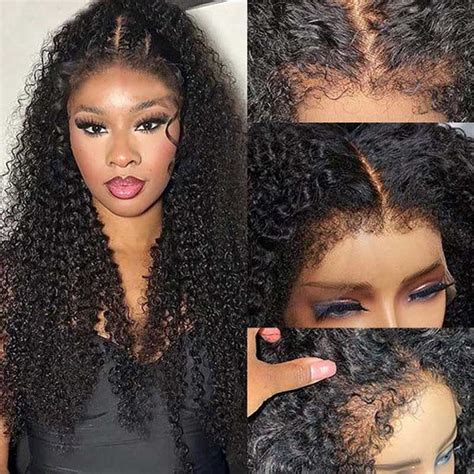What is a 360 Lace Wig?
A 360 lace wig is a type of hairpiece that covers the entire head, providing a natural and seamless look. It is made with lace material around the perimeter of the wig, creating a realistic hairline that blends effortlessly with your own hair. The hair on the wig is typically human hair or synthetic fibers, offering a wide range of styles and colors to choose from.

Benefits of a 360 Lace Wig:
- Natural-looking: The 360 lace creates a flawless transition between your hair and the wig, giving the illusion of natural hair growth.
- Versatile styling: With a 360 lace wig, you can style your hair in numerous ways, including ponytails, buns, and updos, without the wig becoming noticeable.
- Protective: 360 lace wigs protect your natural hair from damage caused by heat styling, chemical treatments, and UV rays.
- Confidence-boosting: A well-fitted 360 lace wig can enhance your confidence by giving you a fuller, more voluminous head of hair.
Pain Points and Motivations:
Many women who consider getting a 360 lace wig face the following pain points:
- Cost: 360 lace wigs can be expensive, especially human hair wigs.
- Maintenance: Wigs require regular cleaning, conditioning, and styling, which can be time-consuming.
- Wig slippage: Improperly fitted wigs can slip or move around on your head, causing discomfort and embarrassment.
However, the potential benefits of a 360 lace wig often outweigh these pain points, motivating women to make the investment:
- Natural beauty: 360 lace wigs can enhance your appearance and make you feel more attractive.
- Hair loss solution: Wigs provide a discreet and effective solution for hair loss due to medical conditions or other factors.
- Expression of individuality: Wigs offer endless possibilities for experimenting with different hairstyles and colors, helping you express your unique style.
How to Choose the Right 360 Lace Wig:
The key to a successful 360 lace wig experience is to choose the right wig for your needs. Here are some factors to consider:
- Hair type: Human hair wigs are more natural-looking but require more maintenance, while synthetic wigs are more affordable and low maintenance.
- Hair density: The hair density refers to the amount of hair on the wig. Choose a density that matches your natural hair or personal preference.
- Hair length: 360 lace wigs come in various lengths, from short to long. Select a length that complements your face shape and personal style.
- Lace material: Swiss lace, French lace, and HD lace are common materials used for 360 lace wigs. Choose a lace that blends seamlessly with your skin tone.
Common Mistakes to Avoid:
To ensure a positive 360 lace wig experience, avoid the following common mistakes:
- Choosing the wrong size: A wig that is too small or too large will create discomfort and a less natural look.
- Applying too much glue or adhesive: Excessive adhesive can damage your scalp and hair, and it can make the wig look unnatural.
- Tying the wig too tightly: Tying the wig too tightly can cause pain and thinning, leading to permanent hair loss.
- Washing the wig with regular shampoo: Regular shampoo can strip the wig of its natural oils and damage the hair. Use a gentle wig shampoo instead.
- Brushing the wig when dry: Brushing a dry wig can create tangles and damage the hair. Always brush your wig when it is wet or conditioned.
Why 360 Lace Wigs Matter:
360 lace wigs have become increasingly popular due to their versatility, natural look, and confidence-boosting benefits. They offer a solution to hair loss, enhance natural hair, and provide endless opportunities for self-expression.
Applications of 360 Lace Wigs:
In addition to the traditional uses as a hairpiece, 360 lace wigs are finding innovative applications in various fields:
- Cosplay: 360 lace wigs allow cosplayers to transform into their favorite characters with realistic hairstyles and hair colors.
- Film and television: Wigs are used extensively in the film and television industry to create various characters and period looks.
- Fashion shows: 360 lace wigs enable models to showcase different hairstyles without the need for time-consuming changes.
- Education: Wigs are used in cosmetology schools to teach students about hair care and styling techniques.
Market Statistics:
According to the American Hair Loss Association, over 50 million men and women in the United States experience hair loss. The global wig and hairpiece market is projected to reach $12.6 billion by 2027, with an increasing demand for 360 lace wigs.
Tables:
Table 1: Pain Points and Motivations
| Pain Point | Motivation |
|---|---|
| Cost | Natural beauty, hair loss solution, self-expression |
| Maintenance | Convenience, time-saving |
| Wig slippage | Confidence, comfort |
Table 2: Hair Type Comparison
| Hair Type | Advantages | Disadvantages |
|---|---|---|
| Human hair | Natural-looking, versatile, long-lasting | Expensive, requires more maintenance |
| Synthetic hair | Affordable, low maintenance, heat-resistant | Less natural-looking, shorter lifespan |
Table 3: Common Mistakes to Avoid
| Mistake | Consequences |
|---|---|
| Choosing the wrong size | Discomfort, unnatural look |
| Applying too much glue | Scalp damage, hair loss, unnatural look |
| Tying the wig too tightly | Pain, thinning, hair loss |
| Washing with regular shampoo | Damage to the wig, shorter lifespan |
| Brushing when dry | Tangles, hair damage |
Table 4: Applications of 360 Lace Wigs
| Application | Benefits |
|---|---|
| Cosplay | Realistic character transformations |
| Film and television | Creation of diverse characters, period looks |
| Fashion shows | Model versatility, time-saving |
| Education | Teaching hair care techniques |
